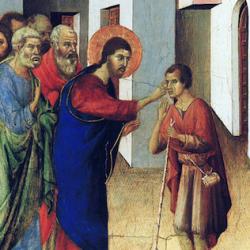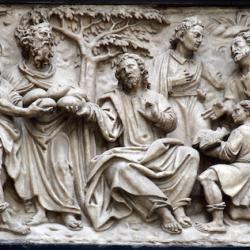The best I can make, at this point, of Matthew’s strange conflated quotation of Jeremiah 18-19/Zechariah 11 in Matthew 27:9-10.
Judas took thirty pieces of silver from the Jewish leaders to betray Jesus. Reading this in the light of Zechariah 11, we know that this expresses the contempt of the Jews for Jesus’ labors as the shepherd who seeks to raise up those who are thrown down (9:36). Also in the light of Zechariah 11, there is the ironic hint that Judas functions as the true shepherd of Israel, the shepherd who is shepherding them toward destruction.
Judas throws the money back in the temple, where it comes before the face of God. Innocent blood is “thrown” in the form of money into the presence of God. God will arise and scatter His enemies, and destroy the house defiled with innocent blood.
The Jews know this, and rapidly remove the defilement from the temple by purchasing a field belonging to a potter. This fulfills the thrust of Zechariah 11, which says that the contemptuous wages are thrown into the house of Yahweh “for the potter.” Perhaps “potter” alludes to Yahweh as potter, the “fashioner” of Adam (Genesis 2:7-8) and, more importantly, the potter who formed Israel for Himself (Isaiah 64:8). Potters or “fashioners” are also linked to idolatry in the Old Testament (Isaiah 44, repeatedly).
That allusion to idolatry brings Jeremiah 18-19 into play, which Matthew alludes to by his mention of Jeremiah as the source of the prophecy. According to 2 Chronicles 28:3; 33:6 and Jeremiah 7:31-32, the valley of Ben-hinnom, also known as Topheth, was a place where innocent blood was shed, where children passed through the fire to Molech. High places were set up for idolatrous worship. It was a “field of the potter” because there idols “fashioned” by craftsmen were worshiped; it was a field of blood because it was the place where human sacrifices were offered. Matthew connects the field purchased by the Jewish leaders with this field of idolatry and the shedding of innocent blood.
The valley of Ben-hinnom, Topheth, Jeremiah says, will become a place of burial. So many will be slaughtered in the coming invasion from Babylon that there will be no place else to bury the dead. The “sacred” grove of Topheth will be defiled by corpses. Matthew also mentions burial, but in Matthew 27, the burial seems to be more a charitable cause.
In the valley of Ben-hinnom, Jeremiah breaks a clay pot, shatters pottery, as a sign of what Yahweh, the Great Potter of Israel, is going to do with the ruined pot of His people. They have filled the land with the blood of the innocent, and so they are going to be shattered. They have behaved like the kings of the earth, resisting the Lord and His anointed, and they will be smashed like pottery (Psalm 2). Matthew issues the same warning to the first-century Jews. They too are a pot destined for destruction.
Finally, Jeremiah 32 might also play a role. There, Jeremiah purchases a piece of land, which is a pledge of Israel’s return from exile, a pledge of their eventual re-possession of the land. Abraham made a similar purchase, importantly a purchase of a burial plot for Sarah, which served as the first bit of land that he owned. Jesus blood, transformed to money, purchases an Abraham-like burial plot in a land that is not His. But it is a pledge of a later inheritance. Jesus’ blood buys the land, and the world.














